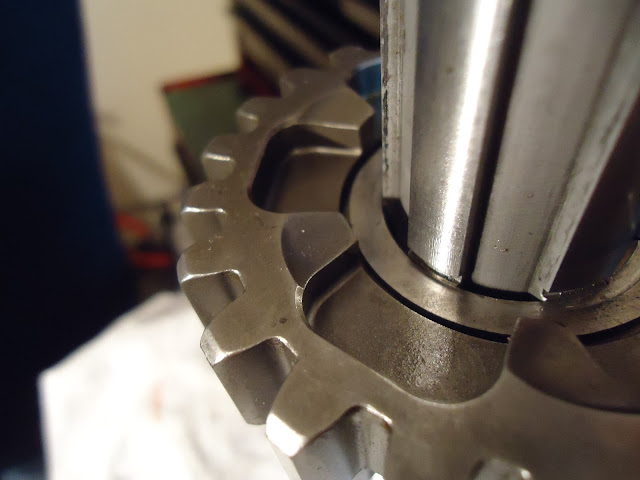All laid and ready to go.(For the most part.) I usually document everything step-by-step as do them, but we were kind of all over the place on getting this one starting. So basically I put my pictures together, in way to help the next guy build one with minimal tangents. Here's everything laid out on the bench. New parts, old parts, and soft parts.

Start with the countershaft gear stack up.
 |
| Figure 1: 4 Speed Countershaft Parts. |
On the left is the new countershaft gear(7) and the new countershaft 2nd gear(9) just laid together. On the right is the old countershaft gear(7) , countershaft 2nd gear(9) and speedo drive(n/d) gear all still assembled.

I'm not running a transmission speedo, but I might in the future so the first order of business is to get the speedo gear off the old countershaft stack.(Not sure where the proper foot for the puller is.)

Once I have everything good and aligned and tight, then a bit of heat. A few more cranks and the gear comes right off. The speedo gear then gets wrapped in aluminum foil and put in a 350° F oven for 15 minutes to get it ready for reassembly.

Now flip over the countershaft gear. The countershaft 2nd gear is attached.

There's a snap ring(13) holding it together. This one had a nice spiral snap ring. Those may normal be re-used unless you don't realize it's a spiral and you destroy it getting it off.

Another flip of the countershaft gear and countershaft 2nd gear(9) and its bushing(12) and thrust washer(14) slip right off.

Pull the bushing from the old gear

Put it in the new gear.

2nd gear(9) with bushing(12) on dog teeth up, then the thrust washer(14).

Brand new snap ring(13)(#35810-36, not sure the number for the spiral version)


The countershaft gear(7) is now fully attached to the countershaft second gear(9).

About the time you have assembled countershaft 2nd onto the counter shaft, the speedo gear is hot enough to go on. It should drop mostly into place. We gently tapped it down with a punch so that is was even with the face of the journal all the way around.

Looking good.

Flip again. The countershaft shift clutch(dog)(8) goes on.There doesn't seem to be an up or down with this Andrews part.

Then the 1st gear thrust washer(15) lays on.

Old 1st gear(10) on the left new 1st gear(10) on right.

Again pull the bushing(11) from the old gear and put into the new gear.

Lay the 1st gear on top of everything else and the counter shaft is pretty much together. Remember that the 1st gear(10), its bushing(11) and thrust washer(15), and the shift clutch(8) are not attached to this assembly. So keep this stacked and put it over to the side for a bit.

On to the mainshaft side for a bit.
 |
| Figure 2. 4 Speed Mainshaft Left Side Parts |
Sadly we were messing around with everything and I didn't get a good picture of the mainshaft(5) and the mainshaft gear cluster(10). Prior to assembly.
I have to give a shout out to Clive from England who hooked me up with me with a nice used Andrews mainshaft. It took a while to get here, because the Royal Postage service and USPS that it was contraband of some sort.
What had us stumped inspecting the fit of the mainshaft gear cluster to mainshaft. The new mainshaft gear cluster didn't slip all the way on to new mainshaft like the two old pieces did. Here's the old mainshaft and gear cluster.

Here's the new mainshaft and gear cluster. And it was bottoming out solid.

So we called Andrew's tech line and Gary assured us that a new gear cluster should not fall onto a shaft, but should be a slight press fit. He also said most used gear clusters will fall on. We honestly weren't convinced, because the it didn't even "try" to go together. Gary had suggested an arbor press, but we didn't have one on had. So we wrapped the gear cluster in aluminum foil and stuck it in the oven at 350° F for 15 minutes. It's steaming in this picture, but I couldn't capture that on film.

Wow! Look at that the hot gear cluster drop all the way on with not addition driving.

Looks like it's a little farther than our original even.

So we continued to check fit our components.This is mainshaft 3rd gear(11) on the mainshaft(5). Do you see the snap ring groove on the mainshaft? That's for the snap ring(13). Although this isn't the time for it yet, that's when I realized my parts list wasn't as complete as I thought it was. I need one of those and also a mainshaft bearing lock tab(7).

We also wanted to check fit the main drive gear(n/d) to the mainshaft.
Remember this is double sealed. So we greased it up.

Mainshaft again didn't want to go all the way.

The top seal didn't give quite right so we thought that was our problem. The fit between the gear and the shaft was already checked prior the seals being installed. So we pulled that seal to further investitate.

Amazingly we didn't mess up the seal pulling it out, but still couldn't get the shaft to go. Even though the deep seal felt fine to the touch. So I added two more seals to the shopping list and we quit for the day.





























































